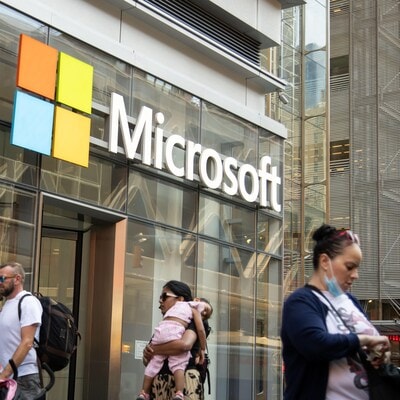)
Hours before reporting its financial results, Microsoft’s Azure and Office 365 services suffered partial outages | Credit: Bloomberg
Microsoft Corp.’s Azure cloud-computing service posted a slowdown in quarterly growth, testing the patience of investors anxious to see a payoff from huge investments in artificial intelligence products.
Revenue from Azure, Microsoft’s main growth engine in recent years, rose 29 per cent in the fiscal fourth quarter, compared with a 31 per cent jump in the previous period. About 8 percentage points of the increase in the recent period was attributable to AI, up from 7 percentage points in the prior quarter.
“It was really about the cloud services number — it needed to just be a little higher,” Doug Clinton, a managing partner at Deepwater Asset Management, said on Bloomberg Television. Still, the accelerated contribution from AI confirms business momentum with that emerging technology, wrote Raimo Lenschow, an analyst at Barclays.
Chief Executive Officer Satya Nadella has been infusing Microsoft’s product line with AI technology from partner OpenAI, including digital assistants called Copilots that can summarize documents and generate computer code, emails and other content. The company also is selling Azure cloud subscriptions featuring OpenAI products. Alongside rivals like Amazon.com Inc. and Google, Microsoft has been spending billions to construct new data centers to meet demand for cloud computing and power-hungry AI services.
On a call with analysts Tuesday, Chief Financial Officer Amy Hood said that although Azure growth will continue to slow in the current quarter, which ends in September, investments in data centers and servers will let the company capitalize on demand and accelerate Azure growth in the second half of fiscal 2025.
Microsoft shares fell less than 1 per cent on Wednesday as the markets opened in New York. As of the Tuesday close, the stock had gained about 12 per cent in 2024.
In the fourth quarter, which ended June 30, capital expenditures — closely watched by investors as the company embarks on its historic AI build-out — jumped to $19 billion, including server farm leases, from $14 billion in the previous quarter. That number will increase in the new fiscal year, Hood said.
In an interview, investor relations chief Brett Iversen said Microsoft currently lacks sufficient capacity to fulfill customer demand for cloud and AI services. “We’re building out for that as quickly as we can,” he said.
In recent weeks, skittish investors have signaled impatience with tech companies’ efforts to profit from their massive investments in AI. Last week, the shares of Google parent Alphabet Inc. sank after the company surprised Wall Street with sharply higher costs that overshadowed strong sales.
Many of Microsoft’s corporate customers are only just starting to use new AI assistants, which still struggle to understand the context of some requests and handle commands involving multiple apps. The Copilot service, which doubles the cost of a monthly subscription to about $60 per user for corporations, is expected to eventually generate a robust flow of recurring revenue.
Iversen said customers are increasingly adopting the company’s higher-tier Office 365 product, which includes generative AI features. Sales from commercial cloud products including Azure and office applications rose 21 per cent to $36.8 billion, Microsoft said, about in line with Wall Street estimates.
Total revenue in the fourth quarter increased 15 per cent to $64.7 billion, while adjusted profit was $2.95 a share, the company said in a statement Tuesday. Analysts on average estimated sales of $64.5 billion and per-share earnings of $2.94.
On the call, Nadella said the number of people using Copilot at work doubled quarter-over-quarter. Use of Copilot within GitHub, which allows for AI assistance in software development, accounts for 40 per cent of revenue growth within that business, he added.
The company’s Xbox video-gaming unit posted 61 per cent growth in content and services revenue, much of that fueled by the $69 billion purchase of Activision Blizzard, which was completed in October.
Hours before reporting its financial results, Microsoft’s Azure and Office 365 services suffered partial outages, which also took down services by customers including Starbucks Corp.
Just a couple of weeks earlier, some 8 million computers running Microsoft’s Windows operating system crashed after the cybersecurity firm CrowdStrike Holdings Inc. released a flawed software update. Though the outage was caused by CrowdStrike, “Microsoft may still have to deal with negative perception around perceived vulnerabilities to its operating system,” Tyler Radke, an analyst at Citigroup, wrote ahead of earnings.
Nadella touted progress in the company’s cybersecurity products during the call with investors. The company says it has more than 1.2 million security customers, and Defender for Cloud, a security product, passed $1 billion in revenue over the past year. “We continue to prioritize security above all else,” Nadella said.
First Published: Jul 31 2024 | 10:49 PM IST
